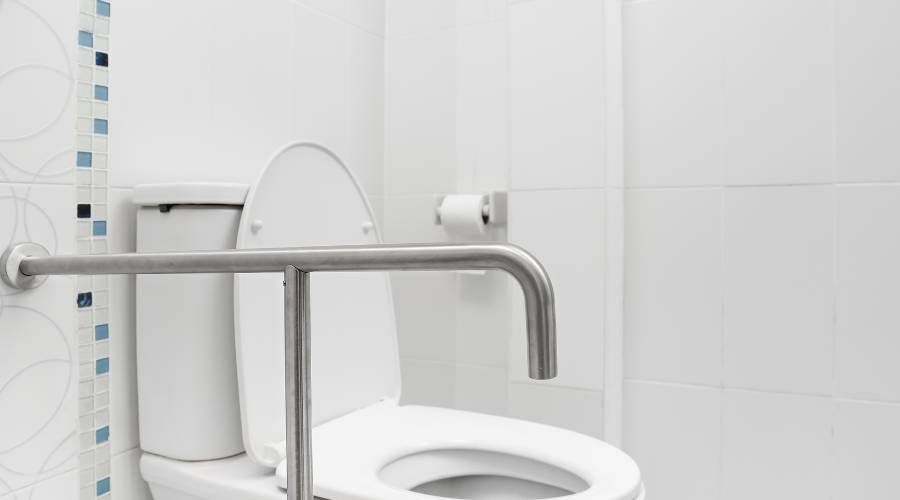A well-designed kitchen should welcome everyone, regardless of age or ability. Accessible kitchen design features create spaces where all users—parents with young children, older adults, or individuals navigating life with mobility aids—can feel comfortable and independent. In busy Sydney households and workplaces alike, an inclusive environment isn’t just about convenience; it’s about dignity, safety, and the freedom to be self-sufficient.
Every day tasks in the kitchen can become challenging if the space doesn’t account for different needs. Hands-free taps, easy-to-reach storage, and wide pathways make meal prep safer for someone recovering from injury or living with a disability. For families supporting ageing loved ones who want to remain at home longer—what’s known as “aging-in-place”—thoughtful design choices can make a world of difference.
- Safety: Reducing trip hazards and ensuring every surface is accessible.
- Ease of Use: Lever handles, pull-out shelves, and appliances that don’t require awkward bending.
- Longevity: Designing now for changing needs means your kitchen adapts as you do.
By embracing accessible design from the start, Sydney homeowners set themselves up for comfort and confidence long into the future. This approach transforms kitchens into welcoming spaces where everyone is empowered to participate fully in daily life.

Key Principles of Accessible Kitchen Design
Creating an accessible kitchen that prioritises safety starts with proper lighting and non-slip flooring.
Proper Lighting for Safety
Adequate lighting reduces the risk of accidents by ensuring all areas of the kitchen are well-illuminated, making it easier for users to see and navigate safely. Consider installing under-cabinet lights to illuminate workspaces and motion-sensor lights to aid those with limited mobility.
Non-Slip Flooring to Prevent Falls
Non-slip flooring is another crucial element in preventing falls. Options like textured vinyl or rubber flooring offer a stable surface that reduces slipping hazards while being easy to clean.
Enhancing Usability with Grab Bars and Lever Handles
To support individuals with mobility challenges, incorporating grab bars and lever handles can significantly enhance usability. Grab bars placed strategically around the kitchen provide sturdy support for those who need assistance moving between different areas. Lever handles are easier to operate than traditional knobs, requiring less force and dexterity, making them ideal for users with limited hand strength or arthritis.
By combining these safety features, you create a kitchen environment that is not only functional but also inclusive and supportive for all users.
Style Considerations in Accessible Kitchen Design
A thoughtfully designed kitchen should feel welcoming and reflect personal style, while delivering smart accessibility solutions. Sydney homeowners often want a space that’s both beautiful and practical—no one wants their kitchen to look clinical or stand out for the wrong reasons.
Balancing Style and Functionality
Modern accessible kitchens embrace sleek cabinetry, subtle colour palettes, and high-quality finishes. Handle-free cupboards with push-to-open features and integrated appliances contribute to a seamless aesthetic without sacrificing ease of use.
User-Friendly Appliances
Selecting appliances designed for simplicity and safety is essential. Look for ovens with side-opening doors, induction cooktops that remain cool to the touch, and dishwashers featuring easy-glide drawers. Many brands now offer these options in a range of colours and finishes, allowing accessibility upgrades to blend effortlessly with your chosen décor.
Blending aesthetics with accessibility ensures everyone feels comfortable using the kitchen without compromising on visual appeal. This approach keeps your renovation timeless and inclusive, key benefits for multi-generational households across Sydney’s diverse suburbs.
Flexibility in Design for an Inclusive Kitchen Space
Ensuring flexibility in kitchen design is key to creating a space that meets the diverse needs of all users. Adjustable countertops and cabinets play a vital role, as they can be modified to suit the height requirements of different individuals. This adaptability makes it easier for everyone, including those with mobility challenges, to use the kitchen comfortably.
To promote inclusivity, providing varied counter heights is essential. Different tasks may require different working heights, so having counters at multiple levels ensures that everyone can find a comfortable and practical workspace. Additionally, ensuring clear knee space beneath counters and appliances allows individuals who use wheelchairs to access these areas with ease.
By incorporating these accessible kitchen design features, you create a more functional and welcoming environment. Flexible designs not only enhance usability but also foster independence and confidence among all users.
Layout Considerations for Optimal Accessibility in the Kitchen Space
A well-planned kitchen layout plays a crucial role in enabling safe, easy movement for everyone, especially those using mobility aids such as wheelchairs or walkers. Prioritising wide doors and aisles makes a world of difference. Aim for doorways at least 820mm wide and aisles that are 1200mm or more, ensuring users don’t feel restricted or at risk of bumping into cabinetry.
Turning space for wheelchairs is equally important. A clear turning circle of at least 1500mm diameter allows wheelchair users to rotate comfortably, reducing the risk of accidents and frustration during daily routines.
Open-concept designs foster inclusivity by removing barriers between kitchen, dining, and living spaces. This approach not only accommodates varying mobility needs but also creates a welcoming environment where family members and guests can interact freely. Homeowners across Sydney’s North Shore and Inner West often find that open layouts blend accessibility with modern, airy aesthetics, making their kitchens truly the heart of the home.
Appliance Placement Strategies to Enhance Usability in an Accessible Kitchen Design
Strategic placement of appliances plays a critical role in ensuring an accessible kitchen that caters to all users. Prioritising accessibility begins with appliance controls:
1. Front or Side Controls
Opting for ovens and dishwashers with front or side controls ensures they remain within easy reach, eliminating the need for bending or stretching.
2. Counter-Height Microwaves
Positioning microwaves at counter height allows for easy access, reducing the strain on individuals who may have difficulty reaching higher shelves.
In addition to these considerations, incorporating pull-out drawers can significantly enhance usability:
- Pull-Out Drawers: These features maximise convenience by providing a smooth mechanism that allows users to access items without excessive reaching or bending.
For an extra layer of accessibility, side-opening ovens can be a game-changer:
- Side-Opening Ovens: This design provides easier access to the oven interior, making it simpler and safer for individuals with mobility issues to handle hot dishes.
By thoughtfully placing appliances and integrating user-friendly features, you create a kitchen environment that is both functional and inclusive.
Storage Solutions That Promote Accessibility in Kitchen Designs Tailored for All Users
A well-designed kitchen empowers everyone to access what they need without strain or assistance. Pull-out shelves bring the back of cupboards within easy reach, eliminating the need to stretch, bend, or kneel. Whether storing pots, pantry items, or cleaning supplies, these shelves glide smoothly and stop firmly, reducing the risk of dropped items or awkward movements.
Adjustable shelving heights add another layer of customisation. By allowing shelf positions to change as needs evolve—children growing taller, older family members preferring lower storage—these accessible kitchen design features adapt gracefully to different stages of life. For example:
- Shallow upper cabinets with movable racks provide flexible storage for everyday items.
- Lower cabinets set on tracks adjust easily for seated users or those using mobility aids.
These thoughtful solutions mean everyone, from busy parents in Roseville to retirees in Bondi, can handle daily tasks confidently and independently.
Additional Features Enhancing Overall Accessibility in a Well-Designed Kitchen Space
Attention to detail can transform a kitchen from standard to exceptional, particularly for those with vision or mobility challenges. Two critical features stand out:
1. Contrasting Edges on Countertops
Incorporating high-contrast edging on benchtops provides an immediate visual cue for people with low vision, helping them distinguish work surfaces from cabinetry and appliances. For example, a dark laminate edge on a light-coloured stone benchtop not only looks modern but also acts as a guide, reducing the risk of accidental bumps or spills. This simple design strategy supports safer, more confident navigation, especially valuable in busy family kitchens or shared spaces.
2. Stable Flooring Materials
Flooring choices play a vital role in both safety and ease of maintenance. Materials such as textured vinyl or slip-resistant tiles offer firm footing and help prevent slips, especially when floors are wet. These surfaces are also low-maintenance—spills wipe up quickly, and there’s less risk of warping compared to timber. Stable flooring gives peace of mind for those using walking aids or wheelchairs, creating a reliable foundation for daily life.
These subtle but impactful enhancements set the stage for a kitchen that feels secure and welcoming to everyone who enters.

Compliance with ADA Standards: Ensuring Legal Requirements Are Met in Accessible Kitchen Designs
Creating a kitchen that’s truly accessible means going beyond design preferences—it’s about meeting legal obligations too. Adhering to ADA standards compliance (or DDA compliance in Australia) is essential for both residential and commercial projects, especially where safety and inclusivity are non-negotiable.
When planning an accessible kitchen, it’s critical to:
- Know the numbers: The ADA (Americans with Disabilities Act) outlines specific dimensions, such as minimum door widths of 810 mm, clear floor space for wheelchairs (at least 1500 mm turning diameter), and maximum countertop heights of 865 mm.
- Plan for access: Required clearances around appliances, sinks, and benches ensure that all users can move and work comfortably.
- Integrate compliant features: Lever handles, reachable controls, and unobstructed pathways help achieve full compliance.
Meeting these standards is not just about ticking boxes—it gives every person the dignity of independent living while protecting property owners from costly legal oversights.
Sydney Renovation Group takes pride in guiding clients through every step of DDA compliance to build kitchens that are both functional and legally sound.
Conclusion
Accessible kitchen design features do more than tick boxes—they open doors to dignity, independence, and daily joy. When you prioritise independence promotion through accessible designs, every choice becomes about empowering the people who use the space, whatever their age or ability level.
Key benefits for Sydney homeowners and businesses include:
- Empowerment & Confidence: People with disabilities or age-related limitations can cook, clean, and gather with loved ones on their terms.
- Safety & Wellbeing: Thoughtful elements such as non-slip flooring, grab bars, and lever handles reduce the risk of accidents, providing peace of mind for families and carers.
- Longevity & Future-Proofing: An accessible kitchen supports ageing-in-place strategies—helping clients stay in their homes longer without costly modifications down the track.
- Aesthetics & Value: Modern accessible kitchens blend style with function. Smart appliance choices and flexible cabinetry mean no compromise on beauty or usability.
“My new kitchen lets me be part of family dinners again. Everything is within reach and looks stunning—thank you for making it possible.”
— Anna, Mosman
Every renovation is a chance to create a space where everyone belongs. By choosing accessible kitchen design features tailored to real-life needs, you invest in freedom, safety, and comfort, making your kitchen the heart of a truly inclusive home or business.
What are the key safety features to consider in accessible kitchen design?
Key safety features in accessible kitchen design include proper lighting, non-slip flooring, grab bars, and lever handles. These elements help prevent accidents and ensure safer use for individuals with mobility challenges.
How can kitchen appliances be made more user-friendly and accessible?
User-friendly appliances in accessible kitchens should have front or side controls, counter-height microwaves, pull-out drawers, and side-opening ovens. These features enhance usability by placing controls within easy reach and improving access.
Why is flexibility important in designing an inclusive kitchen space?
Flexibility allows the kitchen to accommodate different user needs by incorporating adjustable countertops, varied counter heights, and clear knee space beneath counters and appliances. This adaptability supports inclusivity for all users.
What layout considerations improve accessibility in kitchen spaces?
Optimal accessibility is achieved through wide doors and aisles for easy movement, ample turning space for wheelchairs, and open-concept designs that promote seamless navigation throughout the kitchen area.
How do storage solutions enhance accessibility in kitchen designs?
Accessible storage solutions include pull-out shelves and adjustable shelving heights. These features maximize reachability for individuals with limited mobility, making it easier to access kitchen items.
How does compliance with ADA standards influence accessible kitchen design?
Compliance with ADA standards ensures that accessible kitchens meet legal requirements regarding specific dimensions and clearances. Adhering to these guidelines promotes safety, usability, and inclusivity for all users.





